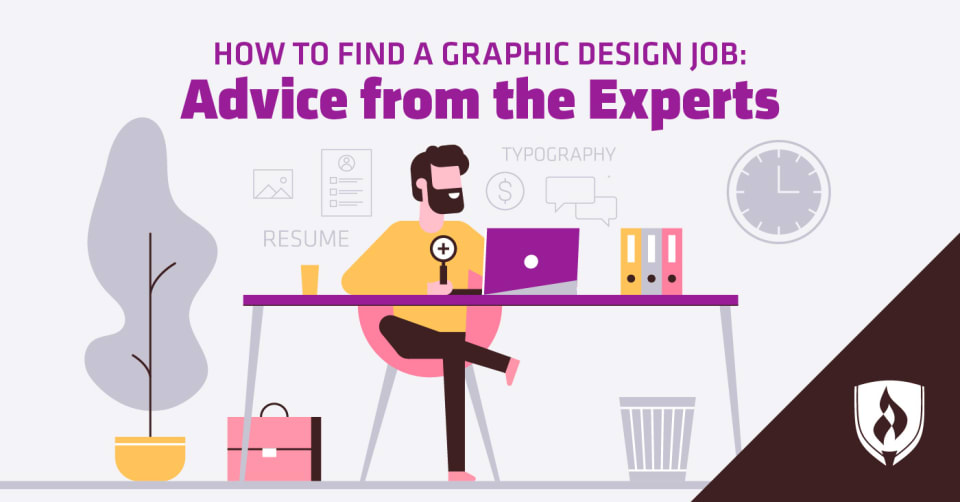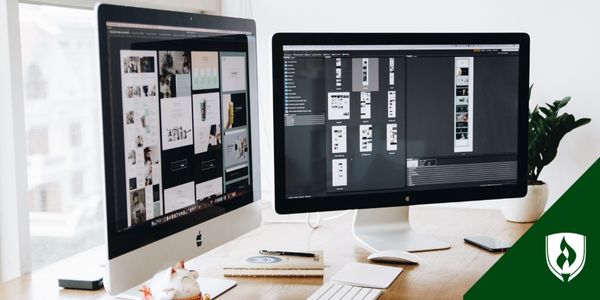
You probably know the drill by now. If you want to find a job, you’ll want to do the following: network, internship, make a LinkedIn profile. But you don’t want just any job. You want a job that will let you pursue your passion—a job in graphic design. There’s just one snag. Jobs like this are so portfolio-driven that the search can seem impossibly daunting. This is especially true for new designers who are just trying to get their bearings.
The good news is that the work is out there. Companies need logos, agencies need cover art, restaurants need menus designed—if there’s a thing that needs to look good, there’s someone looking for the help of a professional to get it there. You just need to find an opening where you can start to get established. To help with that, we’ve compiled several tips and strategies for finding a graphic design job so you can get the ball rolling on a design career.
Different jobs for graphic designers to pursue
One of the best ways to increase your odds of finding a graphic design-related job is to expand upon the job titles you’re seeking out. There are several career options other than “graphic designer” to consider. Try expanding your search with these design-heavy job titles:
User experience (UX) designer
Have you ever visited a website that just felt clunky? There’s an entire field dedicated to avoiding just that! Even if you like the content of the site, a bad user experience can make you think less of the people who own the site. As a UX designer, your job is to prevent this from happening. You want to ensure that when a user clicks or scrolls through a platform, it is as seamless and on-brand as possible.
This position will include things like interviewing users, creating personas, and testing prototypes, but also involves a fair amount of design. After all, the look and feel of an app or website is vital to its success. It should be noted that many UX design positions will require front-end web development skills—so you’ll likely want to brush up before applying.
Production artist
In some ways, a production artist is like the proofreader of the design world. As the primary executors of design work, their role is to carry out a creative vision while ensuring it fits desired specifications. Is the resolution correct? How about the balance? The file type? While responsibilities may vary depending on the employer, this role is generally focused more on the execution of a design more than the brainstorming and overall setting of creative direction. Even if you have long-term ambitions for developing overall creative concepts, this role provides an excellent opportunity to build experience and connections with other design professionals.
Art director
Though this position will require some years of experience in the field, it is a good option to be aware of moving forward. An art director is in charge of overseeing the entire design process. From the initial creative concept to delegating tasks, this job will allow you to put your hand in a variety of graphic design roles.
Tips for finding a graphic design job
Looking to boost your chances of landing a graphic design job? You’ll want to try the following:
1. Start freelancing
Big or small, freelance work is one of the best ways to build your design portfolio, gain experience and make connections with design professionals. Some benefits of freelancing include:
Exposure to work in a new industry
Freelancing can do a lot for your career. Not only will it bolster your portfolio, but it can also inspire you to pursue graphic design opportunities in an industry you’d never thought of before. How about designing product labels for a health foods store? Whipping up brochures for a local nonprofit? By taking on freelance work, you may run into projects that spark a new passion in your job search—complete with connections to that field.
Making agency connections
Freelancing is a great way for you to make a meaningful impression on advertising or marketing agencies who work with a wide variety of clients. Agency work often runs hot and cold—and freelancers are often called in to help out when client workloads spike.
These employers often turn to freelancers to see what a designer is capable of without the risk of bringing on a new full-time employee. Micah Veldkamp, graphic designer for BoldSocks, says his current employer took this approach. He initially reached out and offered to work on a project that they didn’t have capacity for, but after they saw his design skills and work ethic, they eventually offered him a full-time position.
“In a job field that is so results-based, it’s nice for the employer to see the process, efficiency and quality behind a designer’s work,” Veldkamp says.
Though not every freelance project will come with this possibility, don’t be afraid to tell a freelance employer that you are looking for a full-time gig. Remember, employers are not mind readers—for all they know you could be perfectly happy freelancing, so speak up. Even if they don’t have a job opening available right at this moment, they could be looking for help later down the line.
Freelancing could become your full-time job
Once you do a little freelancing, you might find you actually love it—being able to set your own hours, pursue your own clients. It may be unpredictable at first, but some graphic designers choose to go freelance full time.
Looking for a starting point? You can start building your freelance portfolio by visiting these project finder websites:
2. Join a design community
Finding a job is so much more than just combing the internet for listings. There could be thousands of jobs, but if you don’t know where to start, it won’t matter. By getting involved with a design community, you could find the encouragement and direction you need.
These communities can provide a ton of valuable information like job search advice and constructive critiques of your work. They could even help give you an inside track to job opportunities that aren’t advertised publicly. Even if this approach doesn’t lead directly to employment, seeing the work of others and staying connected with a community of designers will help keep you inspired and motivated on your search.
If you want to connect with other designers, start by checking out one of these communities:
- The American Institute for Graphic Arts (AIGA): This is one of the largest design communities out there, but they offer local chapters and events to stay connected as well as many helpful resources for designers.
- The Graphic Design Subreddit: From inspiring examples to tips and tricks, this is a great place to reach out to other designers about questions you might have. Remember to read the rules and FAQs before asking, though.
- Graphic Design GoTo: This private Facebook group is for designers in search of work, community and design resources.
3. Pursue formal education
If you’ve started your job search as a self-taught graphic designer with no college degree, you might be running into issues. No matter whether you think it’s fair or not, employers value candidates with a degree. We used job posting analysis software to review over 53,000 graphic design job postings and found that 78 percent preferred candidates with a Bachelor’s degree at a minimum.1 Remember, employers are risk-averse and are often strapped for time—if two candidates with similar portfolios apply for a job, a degree can be an easy tie-breaker factor for a candidate as it shows they’re invested in the role.
Not only will an education in graphic design increase your skills and provide some proof of your abilities, but it will also provide you with an excellent networking starting point. It’s no secret networking can be pretty awkward. But, if you already have something in common with those connections—like the school you went to—the process can be so much easier.
From your professors to the alumni, a college education can connect you with a community of people that could provide you with an inside track for employment. Many organizations like to lean on their employees for referrals, which means they will often have a few candidates lined up before a job posting is even visible on their site. The more connections you can make, the better your chances of finding these under-the-radar openings.
Start doing what you love
A job search can be tough no matter what profession you’re in. But just remember: You’re on the path to doing something you truly enjoy. Even though you might feel stuck, there are steps you can take to find the job you want—and once you find it, there are steps you can take to get it.
Looking for more advice as you ramp up your graphic design job search? Check out our article “7 Practical Graphic Design Portfolio Tips for Students.”
1Burning-Glass.com (analysis of 53,795 graphic design and desktop publisher job postings, Aug. 1, 2018 – July 31, 2019)
EDITOR’S NOTE: This article was originally published in 2014. It has since been updated to include information relevant to 2019.




